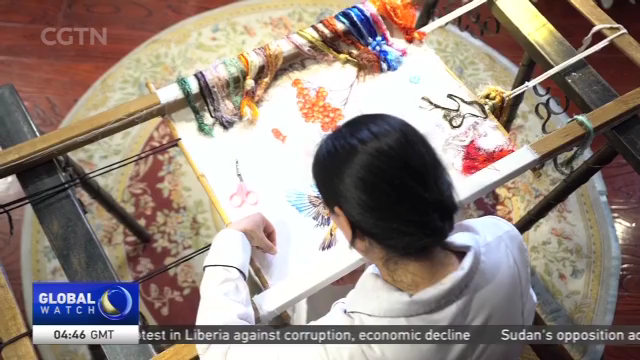
13:52, 08-Jun-2019
Passing Down Traditions: A look at China's ancient craft of silk embroidery
Updated
00:01, 10-Jun-2019
03:25

Silk has long been considered a cultural symbol of China. The tradition of silk production goes back thousands of years. As part of our special series marking the Dragon Boat Festival weekend, CGTN's Xu Mengqi brings us a close look at one of the most elaborate silk crafts - embroidery.
Needlework is common to cultures around the world. But in parts of China, the craft is particularly subtle, because of a unique material: silk. In the ancient town of Tangqi, just outside of the eastern Chinese city of Hangzhou, a millennia-old tradition is on display. After molting four times, silkworms are ready to cocoon. Experienced craftswomen boil them for the silk, and then reel the threads into yarn to make textiles.
XU MENGQI HANGZHOU "Back in the ancient times of the Greeks and Romans, China was known as 'seres', or the nation of silk, thanks to the ancient Silk Road. Today, China's many silk products still give you an idea of how silk is the country's cultural fabric."
CHEN SHUIQIN NATIONALLY ACCLAIMED EMBROIDERY MASTER "Silk threads have a distinct luster that looks different at different angles."
Chen Shuiqin has been doing hand embroidery with silk for 60 years. For her, the craft is the ultimate pursuit of exquisiteness and refined beauty, something that modern craftsmen still need to learn from their ancestors.
CHEN SHUIQIN NATIONALLY ACCLAIMED EMBROIDERY MASTER "We once saw the embroidery collection in the Forbidden City. The fine craftsmanship was really stunning. Nowadays we lack the time and peace of mind to work our skills to perfection."
The long hours and elaborate techniques required of silk embroiderers mean that only the affluent can enjoy such a handicraft. And no one knows that better than Laurence Xu, a Chinese-style haute couture designer. But to design with relevance to contemporary life, Xu also knows that it's imperative to change tradition.
LAURENCE XU HAUTE COUTURE DESIGNER "What were our previous dresses like? Long gowns, Mandarin jackets, all very loose-fitting, so a royal garment would be filled with embroidery from head to toe. But now our clothes are more figure hugging. If we copy the old patterns, they will no longer be beautiful."
Delicate, peaceful, and elegant. However, our aesthetics may change, silk stitches continue to be the crowning jewel of Chinese craftsmanship. The making and appreciation of it call for time and patience, which in today's world are often a luxury. But for artists and designers alike, embroidery is a cultural memory they feel obliged to carry on. XMQ, CGTN.

SITEMAP
Copyright © 2018 CGTN. Beijing ICP prepared NO.16065310-3
Copyright © 2018 CGTN. Beijing ICP prepared NO.16065310-3